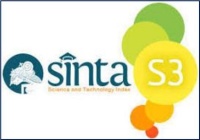Pengaruh Ekstrak Tembuluk Kelapa Merah (Cocos nucifera var. rubescens) Terhadap Penurunan Kadar Glukosa Darah Pada Mencit (Mus musculus)
Abstract
Keywords
Full Text:
PDFReferences
Abdillah, F. M. (2023). Prospek kelapa wulung genjah dari segi pariwisata dan kesehatan di Desa Kuripan Selatan (Vol. 1, Oktober 2023).
Blanter, M., Sork, H., Tuomela, S., et al. (2019). Genetic and environmental interaction in type 1 diabetes: A relationship between genetic risk alleles and molecular traits of enterovirus infection. Current Diabetes Reports, 19(9), 82. https://doi.org/10.1007/s11892-019-1200-5
Care, D., & Suppl, S. S. (2022). Classification and diagnosis of diabetes: Standards of medical care in diabetes—2022. Diabetes Care, 45(Suppl), 517–538. https://doi.org/10.2337/dc22-S002
Dalimartha, S. (2008). Atlas tumbuhan obat Indonesia (Jilid 5). Pustaka Bunda.
Datu, O. S. (2022). Efek pemberian ekstrak buah salak (Salacca zalacca) dalam menurunkan kadar glukosa darah pada tikus model diabetes melitus. Jurnal MIPA, 12(1), 30–33.
Fauziah, N., Yuliawati, K. M., & Kodir, R. A. (2019). Pengujian aktivitas antibakteri dari sabut kelapa hijau (Cocos nucifera L Var. Rubencens) dan sabut kelapa biasa (Cocos nucifera L) terhadap Propionibacterium acnes. Prosiding Farmasi, 5(2), 489–495.
Kawau, D. S., Pakasi, C. B. D., Sondakh, M. L., & Rengkung, L. R. (2015). Kajian pendapatan usaha tani kelapa dengan diversifikasi horizontal pada Gapoktan Petani Jaya di Desa Poigar 1 Kecamatan Sinonsayang Kabupaten Minahasa Selatan. Agri Sosio Ekonomi, 11(3), 41–52.
Khin, P. P., Lee, J. H., & Jun, H. S. (2023). Pancreatic beta-cell dysfunction in type 2 diabetes. European Journal of Inflammation, 21, 1–13. https://doi.org/10.1177/1721727X231162657
Kurniawati, E., & Sianturi, C. Y. (2016). Manfaat sarang semut (Myrmecodia pendans) sebagai terapi antidiabetes. Majority, 5(2), 101–106.
Ludong, R. M., De Queljoe, E., & Simbala, H. E. I. (2019). Uji efektivitas ekstrak buah pinang yaki (Areca vestiaria) terhadap penurunan kadar gula darah tikus putih jantan galur Wistar (Rattus norvegicus) yang diinduksi aloksan. Pharmacon, 8(2), 416–423.
Murtiningsih, M. K., Pandelaki, K., & Sedli, B. P. (2021). Gaya hidup sebagai faktor risiko diabetes melitus tipe 2. E-CliniC, 9(2), 328–336.
Ocktarini, R., Prasetyo, D. H., & Sjarifah, I. (2011). Pengaruh ekstrak herba anting-anting (Acalypha australis) terhadap kadar glukosa darah mencit Balb/C dengan induksi streptozotocin. Biofarmasi, 9(1), 12–16.
Oswari, L. D., & Aldrich, S. (2021). Uji aktivitas penghambatan enzim α-glukosidase ekstrak air dan ekstrak etanol kayu kuning (Arcangelisia flava). Bio Kimia FMIPA Universitas Sriwijaya, 8(1), 1–9.
Pratiwi, E., Putri, A. S., & Gunantar, D. A. (2020). Pengaruh suhu pengeringan pada pembuatan kelapa parut kering (Desiccated coconut) terhadap sifat kimia dan organoleptik. Jurnal Teknologi Pangan dan Hasil Pertanian, 15(2), 10–18.
Putra, M. A. D., Jannah, S. N., & Sitasiwi, A. J. (2020). Uji aktivitas antidiabetes cuka kulit nanas (Ananas comosus L. Merr.) pada tikus putih (Rattus norvegicus) jantan galur Wistar yang diinduksi aloksan. Jurnal Pro-Life, 7(2), 188–197.
Setiadi, E., Peniati, E., & Susanti, R. (2020). Pengaruh ekstrak kulit lidah buaya terhadap kadar gula darah dan gambaran histopatologi pankreas tikus yang diinduksi aloksan. Life Science, 9(2), 171–185.
Sulistijo, S. A. (2021). Pedoman pengelolaan dan pencegahan diabetes melitus tipe 2 dewasa di Indonesia—2021 (Penerbit PB. PERKENI). PERKENI.
Supriani, Harira, L. W., & Fadlilah, N. M. (2021). Pemanfaatan obat tradisional untuk pemeliharaan kesehatan, pencegahan penyakit, dan perawatan kesehatan di era pandemi Covid-19 dengan ramuan bersumber dari Kemenkes RI. Jurnal Global Health Science Group, 1, 23–26.
Syakrawi, M., & Dora, N. (2024). Pengobatan tradisional bluluk dalam menetralisir penyakit diabetes menurut perspektif masyarakat Jawa. Jurnal Pengobatan Tradisional Nusantara, 1, 1–8.
Yuli Wahyu Tri Mulyani, H., Rahayu, L., & Wulandari, D. (2021). Efek antidiare fraksi etanol bakal buah kelapa (Cocos nucifera L) terhadap mencit putih (Mus musculus). Universitas Muhammadiyah Metro.
DOI: https://doi.org/10.33394/bioscientist.v13i2.16418
Refbacks
- There are currently no refbacks.

This work is licensed under a Creative Commons Attribution-ShareAlike 4.0 International License.

Bioscientist : Jurnal Ilmiah Biologi is licensed under a Creative Commons Attribution-ShareAlike 4.0 International License
Editorial Address: Pemuda Street No. 59A, Catur Building Floor I, Mataram City, West Nusa Tenggara Province, Indonesia











